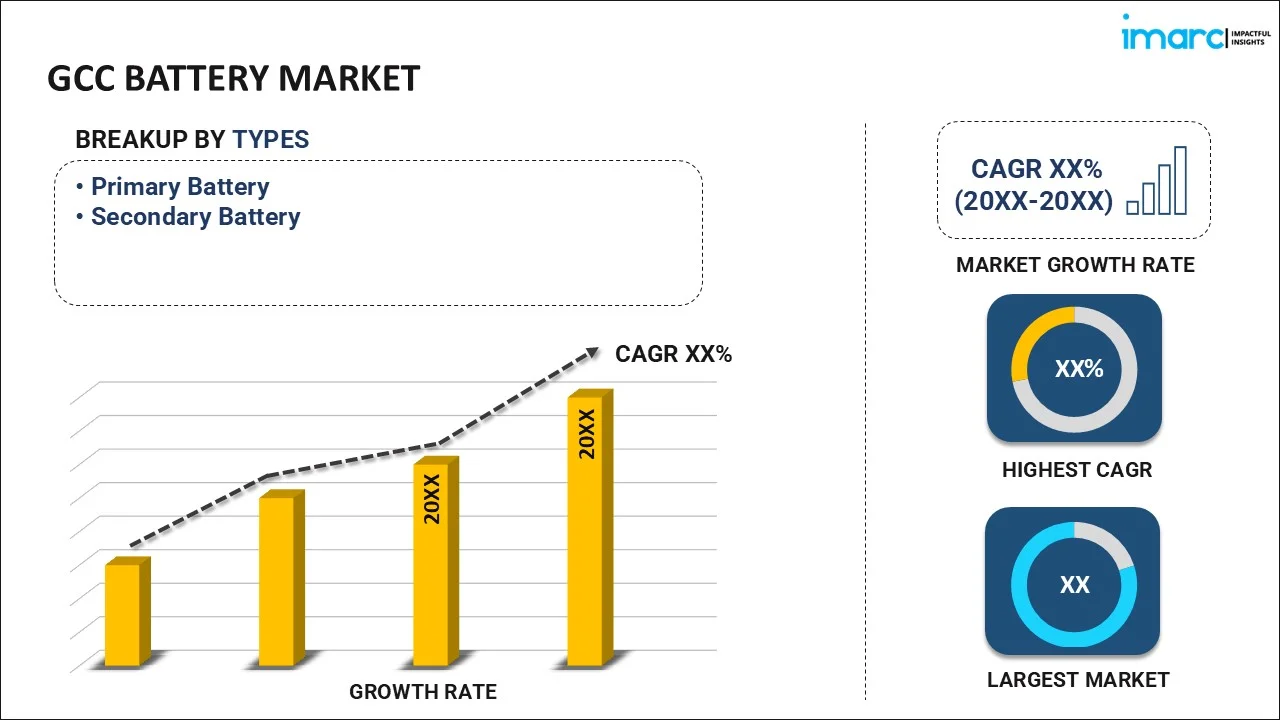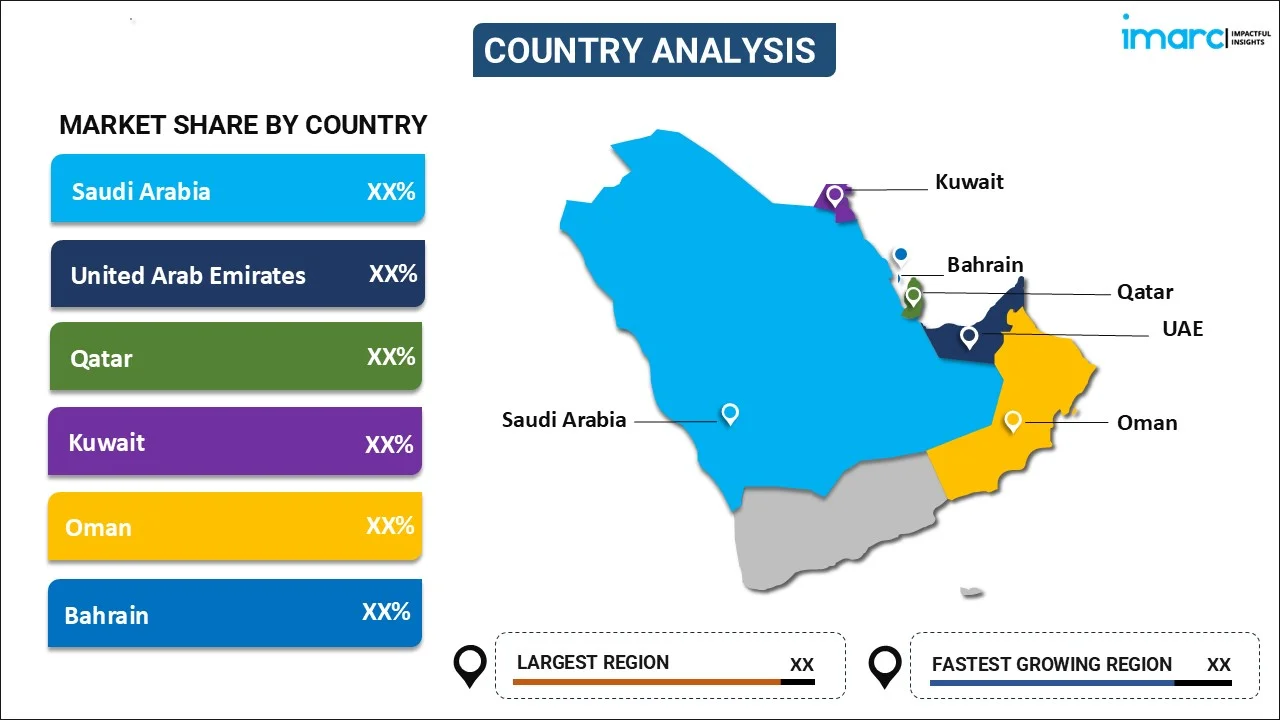
GCC Battery Market Report by Type (Primary Battery, Secondary Battery), Product (Lithium-Ion, Lead Acid, Nickel Metal Hydride, Nickel Cadmium, and Others), Application (Automotive Batteries, Industrial Batteries, Portable Batteries), and Country 2025-2033
Market Overview:
The GCC battery market size reached USD 4.5 Billion in 2024. Looking forward, IMARC Group expects the market to reach USD 8.1 Billion by 2033, exhibiting a growth rate (CAGR) of 6.8% during 2025-2033. The rapid proliferation of renewable energy sources, introduction of electric vehicles (EV), enhanced focus on research and development (R&D) initiatives, advent of smart grid the Internet of Things (IoT) driven applications and the growing need for backup power solutions represent some of the key factors driving the market.
|
Report Attribute
|
Key Statistics
|
|---|---|
|
Base Year
|
2024 |
|
Forecast Years
|
2025-2033
|
|
Historical Years
|
2019-2024
|
| Market Size in 2024 | USD 4.5 Billion |
| Market Forecast in 2033 | USD 8.1 Billion |
| Market Growth Rate (2025-2033) | 6.8% |
A battery is an essential energy storage device widely employed across various industries to power many applications. It consists of one or more electrochemical cells that convert stored chemical energy into electrical energy. They ensure uninterrupted operations and provide mobility for a broad spectrum of equipment. Batteries are known for their portability, enabling the effortless integration of power into devices and systems across different environments. They are also rechargeable, extending their lifespan and reducing waste, which aligns well with sustainability imperatives championed by modern businesses. The potential for energy storage makes them invaluable for stabilizing energy supply from intermittent sources, thus promoting grid resilience and reducing reliance on fossil fuels. Batteries provide quick and reliable backup power, ensuring continuous operations in critical sectors, such as healthcare, finance, and telecommunications, safeguarding against potential losses.
GCC Battery Market Trends:
The increasing demand for batteries as a means to store excess energy due to the proliferation of renewable energy sources, particularly solar and wind, is one of the major factors contributing to the market growth. Additionally, the sudden shift towards electric mobility in the automotive sector, driven by environmental concerns and government initiatives promoting clean transportation, is propelling the market growth. In line with this, the growing demand for lithium-ion batteries, utilized extensively in electric vehicles (EVs), is providing a thrust to the market growth. Moreover, the increasing investments in manufacturing facilities for battery production catering to domestic and global EV markets are positively impacting the market growth. In addition to this, the growing need for uninterrupted power supply across various industries in the region, such as manufacturing, healthcare, and data centers, is favoring the market growth. Besides this, the increasing investment in energy storage solutions by manufacturers, including advanced batteries, to ensure operational continuity during power outages and fluctuations is creating a positive outlook for the market growth. Moreover, the advent of smart grids and IoT-driven applications in power distribution systems, enhancing grid stability and optimizing energy consumption, is supporting the market growth. In line with this, ongoing research and development (R&D) efforts to create high-performance batteries with longer lifespans and faster charging capabilities, reshaping energy storage solutions for industrial and consumer applications, are creating lucrative opportunities for market growth.
GCC Battery Market Segmentation:
IMARC Group provides an analysis of the key trends in each segment of the GCC battery market report, along with forecasts at the regional and country levels for 2025-2033. Our report has categorized the market based on type, product, and application.
Type Insights:

- Primary Battery
- Secondary Battery
The report has provided a detailed breakup and analysis of the market based on the type. This includes primary and secondary batteries.
Product Insights:
- Lithium-Ion
- Lead Acid
- Nickel Metal Hydride
- Nickel Cadmium
- Others
The report has provided a detailed breakup and analysis of the market based on the product. This includes lithium-ion, lead acid, nickel metal hydride, nickel cadmium and others.
Application Insights:
- Automotive Batteries
- Industrial Batteries
- Portable Batteries
A detailed breakup and analysis of the market based on the application has also been provided in the report. This includes automotive, industrial and portable batteries.
Country Insights:

- Saudi Arabia
- UAE
- Qatar
- Bahrain
- Kuwait
- Oman
The report has also provided a comprehensive analysis of all the major regional markets, which include the Saudi Arabia, the UAE, Qatar, Bahrain, Kuwait and Oman.
Competitive Landscape:
The report has also provided a comprehensive analysis of the competitive landscape in the market. Competitive analysis such as market structure, key player positioning, top winning strategies, competitive dashboard, and company evaluation quadrant has been covered in the report. Also, detailed profiles of all major companies have been provided.
GCC Battery Market Report Coverage:
| Report Features | Details |
|---|---|
| Base Year of the Analysis | 2024 |
| Historical Period | 2019-2024 |
| Forecast Period | 2025-2033 |
| Units | Billion USD |
| Scope of the Report | Exploration of Historical and Forecast Trends, Industry Catalysts and Challenges, Segment-Wise Historical and Predictive Market Assessment:
|
| Types Covered | Primary Battery, Secondary Battery |
| Products Covered | Lithium-Ion, Lead Acid, Nickel Metal Hydride, Nickel Cadmium, Others |
| Applications Covered | Automotive Batteries, Industrial Batteries, Portable Batteries |
| Countries Covered | Saudi Arabia, UAE, Qatar, Bahrain, Kuwait, Oman |
| Customization Scope | 10% Free Customization |
| Post-Sale Analyst Support | 10-12 Weeks |
| Delivery Format | PDF and Excel through Email (We can also provide the editable version of the report in PPT/Word format on special request) |
Key Questions Answered in This Report:
- How has the GCC battery market performed so far and how will it perform in the coming years?
- What has been the impact of COVID-19 on the GCC battery market?
- What is the breakup of the GCC battery market on the basis of type?
- What is the breakup of the GCC battery market on the basis of product?
- What is the breakup of the GCC battery market on the basis of application?
- What are the various stages in the value chain of the GCC battery market?
- What are the key driving factors and challenges in the GCC battery market?
- What is the structure of the GCC battery market and who are the key players?
- What is the degree of competition in the GCC battery market?
Key Benefits for Stakeholders:
- IMARC’s report offers a comprehensive quantitative analysis of various market segments, historical and current market trends, market forecasts, and dynamics of the GCC battery market from 2019-2033.
- The research study provides the latest information on the market drivers, challenges, and opportunities in the GCC battery market.
- Porter's five forces analysis assist stakeholders in assessing the impact of new entrants, competitive rivalry, supplier power, buyer power, and the threat of substitution. It helps stakeholders to analyze the level of competition within the GCC battery industry and its attractiveness.
- Competitive landscape allows stakeholders to understand their competitive environment and provides an insight into the current positions of key players in the market.
Need more help?
- Speak to our experienced analysts for insights on the current market scenarios.
- Include additional segments and countries to customize the report as per your requirement.
- Gain an unparalleled competitive advantage in your domain by understanding how to utilize the report and positively impacting your operations and revenue.
- For further assistance, please connect with our analysts.
 Inquire Before Buying
Inquire Before Buying
 Speak to an Analyst
Speak to an Analyst
 Request Brochure
Request Brochure
 Request Customization
Request Customization




.webp)




.webp)












